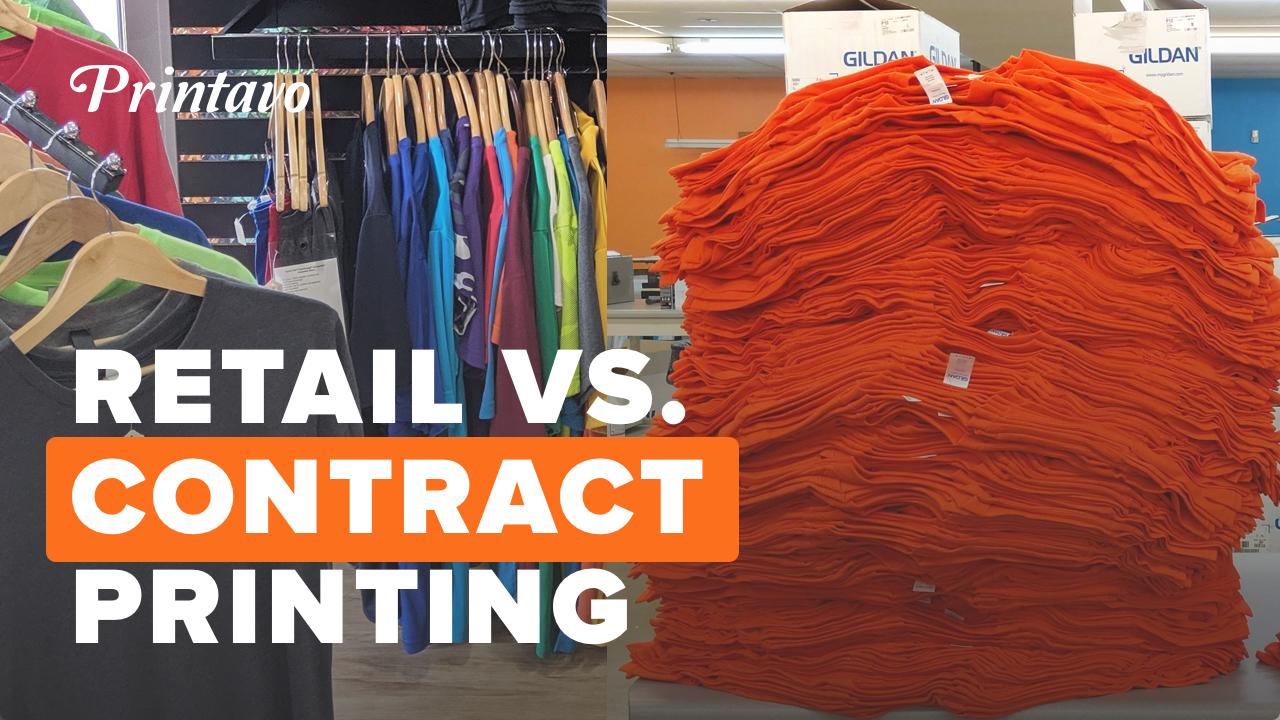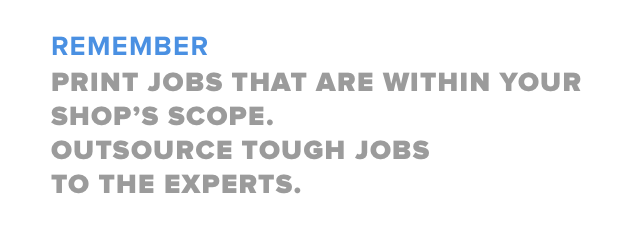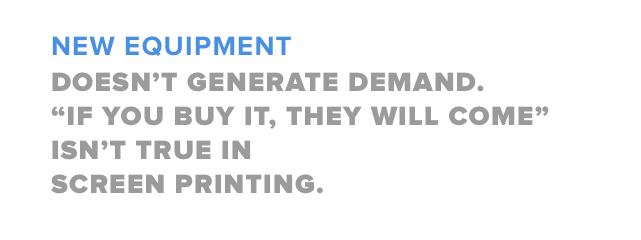Let’s compare contract screen printing with retail screen printing.
Steven Farag from Campus Ink in Champaign, IL talked with Bruce from Printavo about the difference between two major types of screen printing: retail printing and contract printing.
To begin, let’s start with the very basics. We’ll discuss the differences between contract and retail printing – and explain why shops typically do both types of printing.
What is contract screen printing?
Contract screen printing (or contract printing) is when a print shop subcontracts printing to another print shop. This means another print shop does the actual printing. Print shops may subcontract jobs because of the job’s size, difficulty, decoration type, and a variety of other reasons.
What is retail screen printing?
Retail screen printing is when a print shop prints directly for the customer. This is the typical arrangement when we think of screen printing: a customer requests a custom order and the print shop prints and fulfills the order.
Why do screen printers do contract printing?
Contract printing is a great way to leverage another shop’s capacity and specialized skills. Some screen printers prefer to contract print. Pete Junior from New Era Apparel in New York explained, “It’s a rush.“
Some reasons that shops utilize contract printing are:
- Special printing methods. Shops like Denver Print House use water based inks to achieve special effects. Other shops are highly skilled at simulated process printing, while others have special screen printing equipment that lets them achieve different results.
- Lower pricing. Contract printers typically print at a lower cost than retail printers. It can be worth subcontracting a job if there are other, more profitable jobs you can print instead.
- Print brokering. Some print shops don’t maintain a large physical presence. Instead, they subcontract a majority of their actual printing. This is called print brokering. Some shops are extremely successful with this arrangement.
- High-volume jobs. Some shops are not set up for 60,000 piece orders, while others specialize in this type of high-volume printing. Partnering with a contract printer for some or all of a large volume print job is common.
- Embroidery. Many screen print shops don’t do embroidery in-house, and instead subcontract their embroidery to large embroidery mills with hundreds of embroidery heads.
Steven details how contract printing is a bit like accessing someone else’s resources so you can focus on other tasks. You’re using the expertise another shop has developed to bolster your relationship with your customers.
“We have different contractors for screen printing, DTG, embroidery. It’s not bad to broker out jobs you can’t handle! Send big things out to experts. They are there to compliment your business, not compete with you. Contract printers are like an elastic cloud for printing capacity. You need really good relationships with them.”
How do you find contract printers?
The first place you should look for contract printers are local print shops in your town or state.
The best contract printers are close by. Steven explained, “We looked at 1-day shipping or pick-up near our facility. We needed a contract printer, ideally, within 100 miles of us.” Fast turnaround time is crucial.
The easiest ways to meet contract printers are to:
- Call local print shops and inquire. The odds are good that print shops in your area do contract printing. Inquire about your needs.
- Utilize Facebook Groups. Groups like Print Hustlers / Screen Print Gurus, Screen Print Masterminds, and even Screen Printing Q&A each offer access to hundreds of print shops. Users inquire about contract printing every day (and typically find connections very quickly).
- Go to industry trade shows. Trade shows are the easiest and simplest way to meet other printers and make connections. Here’s a few tips for getting the most out of trade shows.
- Join industry groups. Groups like SGIA offer opportunities to connect with printers across the world. They’re also lucrative networking opportunities. For a small yearly fee you’ll gain a lot of access.
- Stay up to date with the industry. Read Impressions and Printwear, keep up to date with the PrintHustlers Blog, read The Ink Kitchen, and follow the industry closely. You’ll develop a sense of “who’s-who” after some digging.
Who does contract printing?
The overwhelming majority of screen printing businesses do some amount of contract printing.
Shops vary in how much they do – some do a 50/50 split, others do more like 80/20, and others do nothing but contract or retail printing – but contract printing remains a viable revenue source.
However, it’s worth noting that contract printing is very competitive.
There are two areas where contract printers make their money:
- Speed and efficiency. Contract printing is all about speed and efficiency. Pure contract printers are focused entirely on printing – they don’t do artwork, handle customers, or do anything except actually print.
- Setup times. Contract printers reduce setup times to the bare minimum. This includes their screen rooms, on-press setups, and breakdown processes.
Being a competitive contract printer requires a focus on efficiency and continuous process improvement. Contract shops are not always large, but they are typically extremely well-oiled operations with documented standards and processes for every step and every role.
What’s the difference between contract printing and retail printing?
The end product (a custom t-shirt, hoodie, or any other kind of custom merchandise) is the same, but the process is different.
If you are contract screen printing, your shop’s brand is not shown to the end customer. The products you print are often drop shipped. Your customer – likely another print shop – will provide garments, artwork, and all necessary details to print the job. You negotiate directly with the other shop about pricing while they deal directly with the customer.
If you are retail screen printing, you work directly with the end customer to fulfill their goals. The products you print may be shipped or picked up by your customer. You communicate with the customer about their needs, provide artwork, procure goods, and then print and fulfill the job. You are responsible from end-to-end for providing top-notch service.
How do contract printing prices compare to retail printing prices?
“Big contract shops have everything set up and dialed in. They charge for screens, ink replacements, unpackaging. There’s a dollar associated with every task in the business. It’s calculated manufacturing. There’s a very small margin for error. Normal direct to consumer shops that dive into contract printing take a lot of jobs that make a small amount of money. You can lose money that way.”
Screen printing pricing is a wildly variable art and science. Contract printers err toward the science side by meticulously tracking every aspect of their printing process – often down to the second through extensive time studies.
For a customer, there’s not much difference between retail and contract printing pricing. But for a print shop, there’s a world of difference.
In contract screen printing, shops typically charge a flat-rate print cost. This is a fee charged per print. A common industry number for contract printing is $0.50 a print, but that’s just a number people use to talk about contract printing.
Contract printing prices vary tremendously, and may include setup fees, art fees, shipping fees, and any other number of additional charges.
In retail screen printing, shops typically price by marking up their garments and adding a print fee to that price. This means retail pricing is typically higher than contract pricing. Retail printing fees can include a variety of additional services.
Setup fees and other charges (like screen and color charges) are part of the game for either type of screen printing. Whether you do contract printing or retail printing, definitely consider upcharges and fees as a part of your pricing model. Bag-and-tag, custom color matching, unique prints, and other custom services add real value to your customers – whether they’re another print shop or a large retail client.
What equipment do you need for contract printing?
While any shop can dive in to contract printing, there’s a very real risk that your shop will wind up in a cash or debt trap if you take on too much contract printing work.
Since the margins are low and the efficiency demands are high, it’s easy to lose money if your shop isn’t carefully set up for contract printing.
Highly efficient and profitable contract shops typically have the following equipment:
- A computer-to-screen or direct-to-screen system. Most large contract shops can quickly burn screens and get them on press. They don’t use film, and instead using something like M&R’s i-Image system.
- An automated screen reclaim process. Screen reclamation is a tedious process that requires a lot of labor. There are automated systems for washing out and reclaiming screens (like M&R’s ECOTEX) that reduce the labor cost and streamline this process.
- Large automatic presses. Large automatic presses are a standby in contract shops. It’s not unusual to see 18 station presses at contract shops. Some shops even utilize oval-shaped automatic screen printing presses to print multiple jobs simultaneously.
- DTG or hybrid printing equipment. While screen printing is still the gold standard, DTG and hybrid printing allows for rapid turnaround (depending on the client’s specifications).
- Powerful shop management software. With shop management software like Printavo, large shops carefully track and time jobs – keeping large teams informed about where jobs are in their process at all times.
- A pod-based layout. Contract shops often orient three automatic presses around one curing dryer. One press is constantly used to set up the next job, while the other two presses are printing. This ensures that there’s very little downtime and the press operators can continuously print.
So why don’t some shops want to contract print?
Obviously, the cost and risks are high.
But there’s other reasons, as Steven explains: “You have to go direct to screen so you can eliminate setup time. You need a good system for artwork approvals. You need print-ready artwork right away. Your artists shouldn’t make custom art. Your press operators need everything dialed-in perfectly. They need to know how long set up takes, how long they’re going to be printing. Not that we can’t do those things, but the level that contract printers are at is extremely high. Unbelievably high.“
Conclusion: use contract printing to build your business
It’s easy to fall into the trap of believing that you need to spend thousands of dollars on screen printing equipment to grow your business. The truth is that subcontracting print jobs is easiest and fastest way to grow your business – without taking on a lot of debt or tying up your cash in equipment.
Contract printers are the screen printing industry’s best resource for growing your business quickly.
You can lean heavily on contract printers to do the actual printing while you develop expertise in customer management, sales, marketing, or even developing skill in a specialized area of printing like simulated process printing.
Some of the most successful print shops outsource and subcontract a majority of their jobs! It can be rocket fuel for growth – low risk and high reward.
There’s even a simple rule of thumb for purchasing new and used screen printing equipment: if you’re making a big purchase, you should have 3 to 4 times the monthly payment in contracted jobs that already go through your shop.
In other words – you can use your volume of contracted printing as a gauge for sustainable growth.
Have a lot of customers and send a lot of contracted jobs out? Maybe it’s time to move printing in-house and start taking a bigger cut.
Want a shiny new press? Consider using contracting first to build a solid cash flow before you take the leap.
More reading about some fascinating contract screen printers that have created success:
- Pete Junior made hundreds of thousand of dollars off Facebook as a contract printer
- Rick Roth printed millions of t-shirts. You’ll want to hear what he has to say.
- Jon Weiss co-created simulated process printing and changed the merchandise world forever.







0 Comments